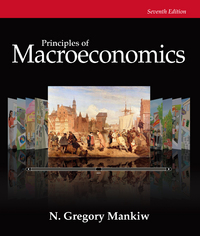Question
all parts to the following two questions. Given the following information: Total Product (TP) Price Fixed Cost (TFC) Variable Cost (TVC) 0 $600 $200 $
all parts to the following two questions.
- Given the following information:
Total Product (TP) Price Fixed Cost (TFC) Variable Cost (TVC)
0 $600 $200 $ 0
1 600 200 900
2 600 200 1200
3 600 200 1500
4 600 200 2000
5 600 200 2600
6 600 200 3500
- Solve for total cost (TC), average fixed cost (AFC), average variable cost (AVC),
average total cost (ATC), marginal cost (MC), total revenue (TR), and marginal revenue
(MR) at every total product quantity.
- What is the profit maximizing level of total product (TP) in this example?
- At a quantity of 1, will this firm produce or shutdown? Explain.
How much of a profit or loss does the firm incur based upon their decision to produce or
shutdown?
- At a quantity of 2, will this firm produce or shutdown? Explain.
How much of a profit or loss does the firm incur based upon their decision to produce or
shutdown?
- At a quantity of 3, will this firm produce or shutdown? Explain.
How much of a profit or loss does the firm incur based upon their decision to produce or
shutdown?
- At a quantity of 4, will this firm produce or shutdown? Explain.
How much of a profit or loss does the firm incur based upon their decision to produce or
shutdown?
- At a quantity of 5, will this firm produce or shutdown? Explain.
How much of a profit or loss does the firm incur based upon their decision to produce or
shutdown?
- At a quantity of 6, will this firm produce or shutdown? Explain.
How much of a profit or loss does the firm incur based upon their decision to produce or
shutdown?
- The following table depicts the prices and total costs faced by a local used bookstore.
The bookstore competes with a number of other bookstores, and therefore operates in a
competitive (you will need to determine if it is a purely competitive or a monopolistically
competitive) marketplace.
Total Product (TP) Price per Book Total Costs
0 $5.00 $ 1.50
1 4.75 4.00
2 4.50 6.00
3 4.25 7.50
4 4.00 9.50
5 3.75 12.50
6 3.50 16.00
7 3.00 21.00
8 2.50 28.00
a. Calculate the store's total revenue, marginal revenue, average total cost, and
marginal cost at each total product (TP) level.
- What is the profit-maximizing level of total product for the bookstore? How much profit is being earned at this total product level?
- Based upon the data provided, is this firm a purely competitive firm or a monopolistically competitive firm? Explain.
- At each total product level, state whether the demand is elastic, unit elastic, or inelastic.
- How does the elasticity value relate to the marginal revenue values?
- Would the firm produce when the demand is elastic? Explain why or why not.
- Would the firm produce when the demand is unit elastic? Explain why or why not.
- Would the firm produce when the demand is inelastic? Explain why or why not.
- Graphically represent this short-run situation by plotting demand, marginal
revenue, marginal cost, and average total cost on the same graph. On your graph, make sure to show the profit maximizing quantity and price as well as the profit or loss area.
- Given your results from parts a and b, explain what will happen to the demand and costs for this bookstore as it transitions from the short run into the long run.
Step by Step Solution
There are 3 Steps involved in it
Step: 1

Get Instant Access to Expert-Tailored Solutions
See step-by-step solutions with expert insights and AI powered tools for academic success
Step: 2

Step: 3

Ace Your Homework with AI
Get the answers you need in no time with our AI-driven, step-by-step assistance
Get Started


